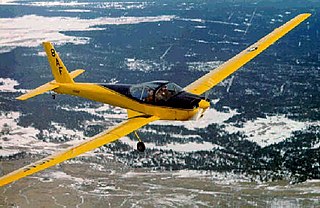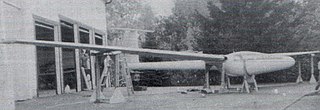
The National Soaring Museum (NSM) is an aviation museum whose stated aim is to preserve the history of motorless flight. It is located on top of Harris Hill near Elmira, New York, United States.

The Schweizer SGM 2-37 is a two-place, side-by-side, fixed gear, low wing motor glider.
The Schweizer SGU 1-19 and Schweizer SGU 1-20 are a family of United States single-seat, high-wing, strut-braced, utility gliders built by Schweizer Aircraft of Elmira, New York.
The Nelson Aircraft Corporation was founded in 1945 by sailplane pilot Ted Nelson and sailplane designer William Hawley Bowlus in San Fernando, California.

The Bowlus BA-100 Baby Albatross is an American high-wing, strut-braced, open cockpit, pod-and-boom glider that was designed by Hawley Bowlus and introduced in 1938.

The Bowlus BS-100 Super Albatross is a single seat, mid-wing glider that was designed by Hawley Bowlus in 1938.
The Nelson H-44 is an American single ignition, four-cylinder, horizontally opposed, direct drive, two-stroke aircraft engine that was developed by the Nelson Engine Company for use in motorgliders.

The Nelson Hummingbird PG-185B is an American, tandem two seat, mid-wing motor glider that was developed by Nelson Aircraft after discontinuing the Nelson Dragonfly.

The Rutan Model 77 Solitaire is an American, single seat, canard, mid-wing motor glider that was developed by Burt Rutan in response to the 1982 Sailplane Homebuilders Association Design Contest for a homebuilt glider. It first flew in 1982. The Solitaire was declared the winner of the contest and its unusual layout attracted a great deal of attention. For a time in the 1980s the aircraft was available as plans and as a kit.
The Applebay Zia is an American, single-seat, high-wing, twin-boom, pusher configuration motor glider that was designed by George Applebay for the 1982 Sailplane Homebuilders Association Homebuilt Sailplane Design Contest. The aircraft was intended to be offered as a factory completed aircraft or as a kit. It first flew in 1982.

The Ryson ST-100 Cloudster is a tandem two-seat, low-wing, conventional landing gear motor glider that was designed by T. Claude Ryan first flown in 1976 and certified in 1983. The aircraft was intended to be used as both a motor glider and a light aircraft and was type certified in both categories.

The Schreder Airmate HP-11 is an American mid-wing, V-tailed, single seat glider designed by Richard Schreder. Airmate was the name of Schreder's design company.

The Bowlus BZ-1 is an American single seat FAI 15 Meter Class, V-tailed glider that was designed and built by Michael Bowlus.

The Luenger Beta 1 was an American high-wing, single-seat, T-tailed FAI Open Class glider designed by Hans Luenger and Spud Kohler.
The Perl PG-130 Penetrator is an American mid-wing, single-seat glider that was designed and constructed by Harry Perl.

The Schleicher ASK 14 is a West German low-wing, single-seat motor glider that was designed by Rudolf Kaiser and produced by Alexander Schleicher GmbH & Co.
The Haufe Buzzer 2 is an American high-wing, strut-braced single-seat motor glider that was designed and constructed by Walter Haufe.

The Diamond HK36 Super Dimona is an extensive family of Austrian low-wing, T-tailed, two-seat motor gliders that were designed by Wolf Hoffmann and currently produced by Diamond Aircraft Industries.
The Parker 2nd Ranger, also called the Parker Ranger is an American mid-wing, single-seat motor glider that was designed and constructed by W.L. Parker of La Grande, Oregon, first flying in 1967.

The Raab Krähe is a West German high-wing, single-seat, pusher configuration motor glider that was designed by Fritz Raab for amateur construction around 1958.













